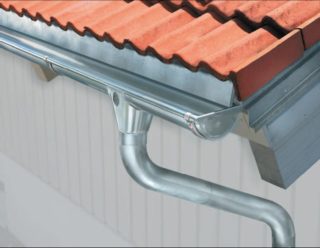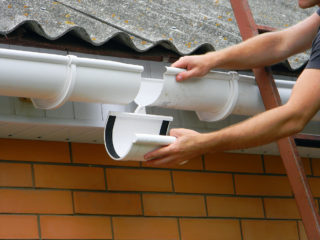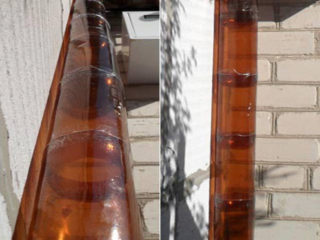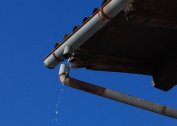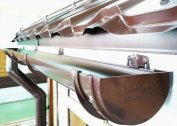To rainfall, flowing from the roof, did not destroy the walls and foundation, establish a drainage system. It can be made of various materials, but the principle of fastening and functions are the same. If you have experience, you can make a drain with your own hands. In the absence of time, you can order the finished system in a specialized company, whose representative first measures the dimensions of the house, and then gradually installs all parts of the structure.
Types and arrangement of drainage systems, selection of materials
Distinguish drainage systems according to the method of manufacture, materials and method of attachment. To increase the life of the drain and reduce the risk of ice formation, you can perform a number of additional measures - install heating or attach a grid so that debris does not fall into the gutters. It is desirable that a storm sewage system be equipped on the site, drains from which can be diverted to a separate clean septic tank or into a ditch outside the site. This will keep the lawn in proper form, and also help to avoid the appearance of puddles and flooding.
Gutters are usually made of lightweight materials so that fasteners do not damage the plaster and do not fall off under their own weight. At the same time, they must be resistant to corrosion and decay, otherwise you will often have to make repairs and replace failed sections of the gutters.
Metal drain
Gutters used to be made of galvanized steel. Now this method is still used, although new, much more practical materials for installing drainpipes have appeared. Galvanized steel is a lightweight material, but has its drawbacks - if you damage the metal, it will quickly rust and will have to be replaced. The cost of such a drain is available to most owners of private homes, but the appearance leaves much to be desired - it cannot be painted in a different color, therefore, the structure will stand out against all other details of the facade.
The galvanized gutter system can be made by yourself. The material lends itself well to correction, so any inaccuracies in measurements are easy to correct.
Other alloys are also used - based on copper, titanium. They last longer, but the cost is higher. Mounts for gutters are made of the same metal and are attached to the finished roof.
Aluminum is quite suitable for the manufacture of gutters. It does not give in to corrosion, serves more than 50 years, is convenient in work.
Copper plates look luxurious, but at a price they come out expensive, especially if the mounting material is also made of copper.
Plastic gutters
You can buy ready-made or make it yourself from pieces of plastic pipe. To do this, choose a suitable material with thick walls, cut it in half with a grinder, grind the badass and hang it on the mounts. The fastening material in this case is made of available materials, for example, metal.
Plastic has several advantages:
- does not give in to corrosion therefore lasts longer;
- with mechanical damage, the functionality does not decrease;
- long service life - more than 50 years;
- has a smooth surface, so various debris is quickly washed off by streams of water;
- you can choose the right color, as there are different shades of polymers on sale;
- the material is resistant to ultraviolet radiation.
The disadvantage of plastic is that it cannot be adjusted if measurements are made inaccurately. The only way is cropping.The cost of polymeric materials is higher than galvanized steel.
Polymer coated metal
The cost is cheaper if you do it yourself. Custom models are expensive. The material requires careful installation and operation, as the slightest scratch can trigger the process of rust. In this case, the appearance will begin to gradually deteriorate.
The advantage of the products is that you can choose the color for any shade of tiles, which will immediately affect the appearance of the house. Smooth polymer coating does not contribute to the accumulation of debris. When it rains, it is completely washed off. Plastic tolerates temperature extremes and exposure to sunlight, therefore, with careful use, it can last a long time.
Plastic bottles as a drain material
If there is a need to equip the water drainage system urgently and cheaply, you can use plastic bottles of 5 liters. To do this, the neck, bottom and narrow part are cut off, and the bottle is cut in half. From these parts, an outlet chute is laid out lapped, which is screwed into wooden slats. The upper gutters are made in a similar way, but 2 liter bottles are used. From the middle of the roof, which is the highest point, the plates are laid out to the edges of the house. Large bottles are placed in the corners, through which water flows into a makeshift gutter and then beyond the boundaries of the site.
This option is suitable for a country house, if there are no aesthetic plans.
Design and implementation of necessary calculations
Any construction work must be performed after preliminary calculations. No need to try to combine the details of the drainage system of different manufacturers - there may be a mismatch between the size of the fasteners and the diameter of the gutters and other nuances.
When making calculations, you need to consider:
- average rainfall in a given region;
- the size of the largest slope of the roof to select a gutter of the appropriate size;
- the location of the gutter relative to the roof so that water does not fall on the walls;
- length of the ramp.
The approximate dimensions of the gutters and drain pipes at a rainfall of up to 100 mm per hour:
- a chute with a diameter of 100 mm, a drain pipe - 75 mm;
- groove 125 mm, pipe 90 mm;
- gutter 150 mm, pipe 110 mm.
The slope of the gutters must be observed so that the water does not stagnate and does not overflow, but flows into the drain pipe. For every 4 cm of distance, 1 cm of slope is calculated. This increases the length of the workpieces, so they are calculated in advance.
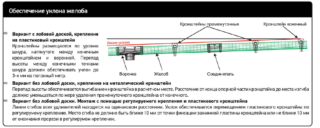 Provide for the presence of angular internal and external gutters. They redirect the movement of water. Also take into account the cost and number of fasteners. They are installed every 60 - 70 cm around the perimeter.
Provide for the presence of angular internal and external gutters. They redirect the movement of water. Also take into account the cost and number of fasteners. They are installed every 60 - 70 cm around the perimeter.
It is important to minimize the number of joints, so you need to buy so much material so as not to use small pieces of plastic or metal. The reliability of the design in this case will be higher. There are two sizes of gutters on sale - 3 and 4 meters long. If necessary, you can cut a small piece from each and place two or three identical parts under the roof.
After determining the size, you can calculate the cost of materials and their quantity. Take into account the screws that will be attached to the system, as well as rubber gaskets, funnels and plugs. Hooks can be attached in two ways: if the roof is already ready, use the short option, if the roof is not finished, you can attach a long hook.
Tools required for work
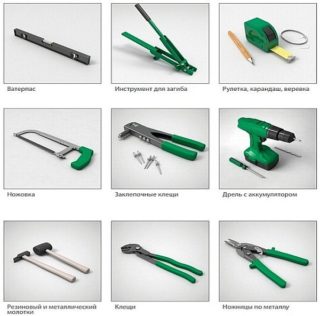 If you plan to do the work yourself, you need to prepare the following set of tools:
If you plan to do the work yourself, you need to prepare the following set of tools:
- hacksaw for metal or grinder;
- scissors for metal, if you plan to cut sheet aluminum or galvanized steel;
- tape measure for measurements of at least 7 meters;
- pipe clamps;
- building level;
- cord for marking the slope of the brackets;
- flat bend for bending hooks;
- hammer;
- screws for screwing brackets and clamps to the wall;
- stairs;
- screwdrivers or screwdriver.
It is better not to use a grinder for cutting plastic, since during friction the material overheats and melts, which affects the evenness of the cut and the quality of the product.
Installation Steps
Work begins with determining the slope of the brackets and marking the level with a cord. Fasteners are mounted from the corner of the house. Installation steps after all hooks are screwed:
- Funnels are cut out in those places of the water intake where the drain pipes will be attached.
- Install the water intake and screw it to the hooks. The slope of the roof should be in the middle of the water intake, so that with heavy rain water gets into the gutter.
- In the corner parts put rotary parts or plugs.
- To equip the drain, 2 pipe connections are performed according to the elbow type. Do it from top to bottom.
- In the lower part, a drain is carried out, which is sent to the storm grate or specially equipped ditches.
- Pipes are attached to the wall using clamps. It is not recommended to tighten them, so that during temperature changes the system can move freely in any direction.
To install a heating system on the drainpipes, you must have the skills to handle electrical appliances. Otherwise, it is better to call a specialist and set a task.
To prevent falling leaves and bird droppings from clogging the system, a grid with small holes is fixed over the gutter.
Common mistakes when installing drainage systems
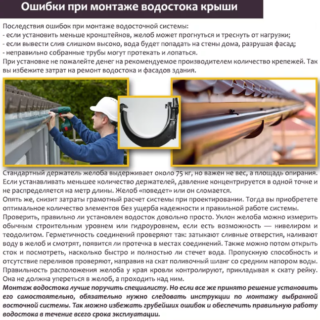 If the size of the gutters is incorrectly selected, part of the water will overflow. With heavy rainfall, it will fall on the wall and wash off whitewash or paint. Also, overflow is possible if the angle of installation of the water intake relative to the roof slope is incorrectly selected.
If the size of the gutters is incorrectly selected, part of the water will overflow. With heavy rainfall, it will fall on the wall and wash off whitewash or paint. Also, overflow is possible if the angle of installation of the water intake relative to the roof slope is incorrectly selected.
The number of funnels must match the number of vertical drain pipes. Their lack can also lead to overflow. The absence of plugs at the edges of the gutters will cause a powerful flow of water in the corners of the house.
Savings on brackets and hooks can cause sagging of the gutter system and even its collapse in the winter, because ice and snow accumulate in the gutters.
If you use PVC for the manufacture of water receivers, fastening the gutter can not be done with a tight joint - with an increase in temperature, PVC expands and can burst.
Lack of slope leads to overflow of water. On houses with a large roof area, a double bias is made - from the middle of the roof to its corners in order to evenly distribute the load during rain.
An insufficient number of clamps can play a bad role during a squally wind - the drainpipe will simply tear off the wall, damaging the plaster. You should also fasten the drain pipe at a certain distance from the wall so that it has time to dry out and does not create high humidity.
Leaks can occur due to improperly installed rubber gaskets at the junction of the funnel and drain pipe.
The lack of a protective grill on the gutters can cause dirty water to flow with debris at the beginning of the rain, after which you will have to clean the area.
The cost of the drain can be reduced if the main work is done with your own hands. The price for the installation of the drainage system in this case will not be taken into account. It remains to count the number of pipes, brackets and hooks. You may need to purchase any construction tools and supplies.
